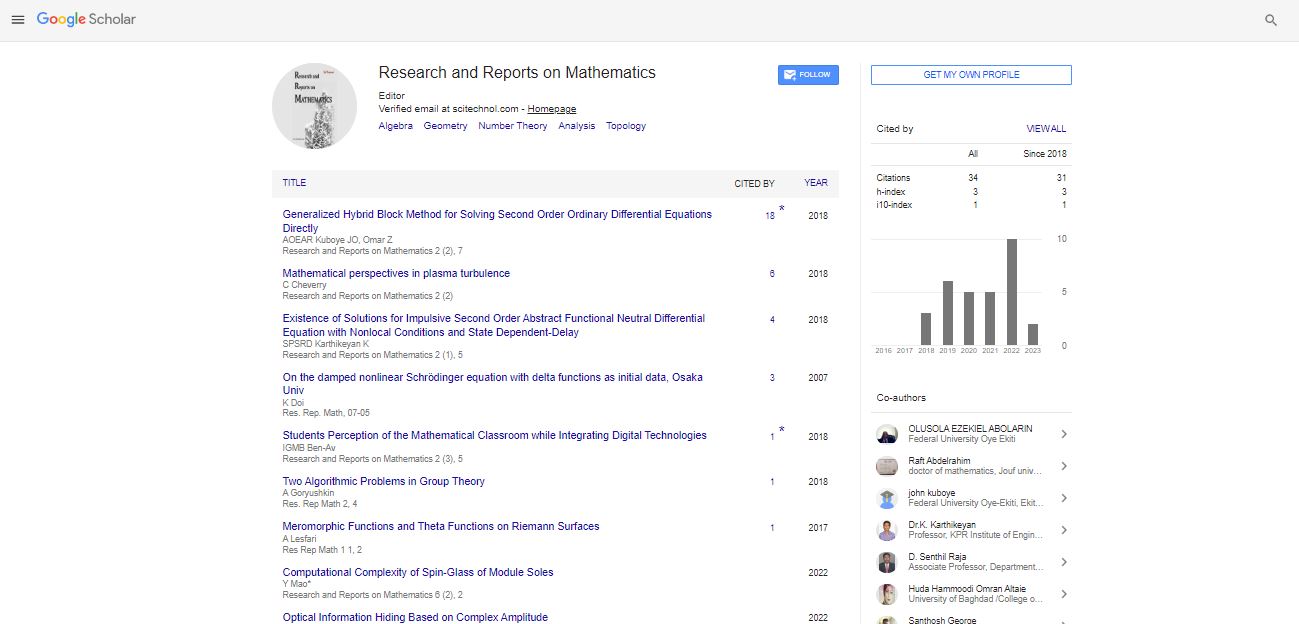Opinion Article, Res Rep Math Vol: 8 Issue: 1
Homotopy Theory and Topological Data Analysis
Jong Suk*
Department of Mathematics Education, University of Haifa, Haifa, Israel
- *Corresponding Author:
- Jong Suk
Department of Mathematics Education,
University of Haifa,
Haifa,
Israel
E-mail: jongsuk123@gmail.com
Received date: 27 October, 2023, Manuscript No. RRM-23-118497;
Editor assigned date: 30 October, 2023, PreQC No. RRM-23-118497 (PQ);
Reviewed date: 13 November, 2023, QC No. RRM-23-118497;
Revised date: 11 January, 2024, Manuscript No. RRM-23-118497 (R);
Published date: 18 January, 2024, DOI: 10.4172/rrm.1000225
Citation: Suk J (2024) Homotopy Theory and Topological Data Analysis. Res Rep Math 8:1.
Introduction
The fascinating intersection of homotopy theory and Topological Data Analysis (TDA). Homotopy theory, a branch of algebraic topology, offers powerful tools for understanding the shape and structure of data. When combined with TDA, it opens up new avenues for data analysis, visualization, and feature extraction.
Topological Data Analysis (TDA) has gained recognition as a powerful tool for extracting meaningful information from complex data. At its core, TDA employs methods from algebraic topology to analyze the shape and structure of data. Homotopy theory, a foundational branch of algebraic topology, plays a crucial role in understanding the topological properties of spaces and, by extension, the structure of data.
One of the foundational ideas in homotopy theory, this concept defines when two topological spaces can be continuously deformed into one another without any tearing or gluing. It offers a robust notion of equivalence in the realm of topology, enabling the study of topological spaces in a more flexible and intuitive way.
Homotopy theory introduces homotopy groups, denoted as π_n(X), which are vital in characterizing the topological properties of spaces. These groups help in classifying spaces based on their connectedness and the presence of "holes." Homotopy groups provide a systematic approach to understanding and distinguishing different topological spaces.
Description
Homotopy theory has applications in various fields
Topological Data Analysis (TDA): In data science, homotopy theory plays a significant role in TDA. It aids in extracting meaningful insights from complex data by tracking the persistence of topological features, such as connected components, loops, and voids. These insights help in data clustering, pattern recognition, and anomaly detection.
Shape analysis: Homotopy theory is essential in shape analysis, as it enables the comparison and classification of shapes using topological concepts. This is particularly valuable in computer vision, image recognition, and object classification.
Biology: Homotopy theory is applied in biology to understand the topology of complex biological structures. It is used to study processes such as protein folding, neural connectivity, and spatial organization in tissues and organs.
Materials science: Materials scientists use homotopy theory in studying porous materials, including their permeability and transport properties. This knowledge contributes to advances in material design and engineering.
Homotopy theory continues to be an active area of research, offering powerful tools for analyzing and understanding the structure of spaces, both in the mathematical realm and in practical applications. Its deep connections to topological data analysis make it an exciting area of study that bridges theory and real-world problem-solving.
At the heart of homotopy theory is the concept of homotopy equivalence. Two topological spaces are considered homotopy equivalent if one can be continuously deformed into the other without tearing or gluing. This notion provides a powerful tool for understanding the "sameness" of spaces in a topological sense.
Homotopy groups, denoted by π_n(X), classify the topological properties of a space X. They provide a way to determine how many "holes" exist in X and offer a systematic approach to studying topological invariants.
Persistent homology, a key TDA technique, captures the evolution of topological features in data. By applying the concept of homotopy theory, TDA reveals the persistent components, loops, and voids within data points. This information can be invaluable for recognizing patterns, clusters, and anomalies in complex datasets.
The Mapper algorithm is a TDA tool that creates a network representation of data, providing a simplified visualization of data's topological structure. By employing ideas from homotopy theory, Mapper constructs a graph that reveals the underlying shape of the dataset.
Applications of homotopy theory in TDA
Homotopy theory is particularly useful in shape analysis. By representing shapes as topological spaces, researchers can use homotopy concepts to compare and classify different shapes. This has applications in image recognition, object classification, and more.
In biology, TDA with homotopy theory can help analyze complex structures, such as protein folding or neural connectivity. This enables researchers to identify critical topological features and gain deeper insights into biological systems.
Materials scientists use TDA and homotopy theory to explore the characteristics of porous materials and study their permeability and transport properties, leading to advances in material design and engineering.
While the combination of homotopy theory and TDA holds great promise, there are challenges, including the computational complexity of TDA, the need for efficient algorithms, and the development of robust software tools. Future research may focus on addressing these challenges and expanding the range of applications in various domains.
Conclusion
Homotopy theory, with its focus on topological properties, has enriched the field of topological data analysis. By incorporating the principles of homotopy theory, TDA offers a powerful approach to understanding and extracting meaningful information from complex datasets. As TDA continues to evolve, it is likely to find even broader applications across multiple disciplines.
 Spanish
Spanish  Chinese
Chinese  Russian
Russian  German
German  French
French  Japanese
Japanese  Portuguese
Portuguese  Hindi
Hindi 